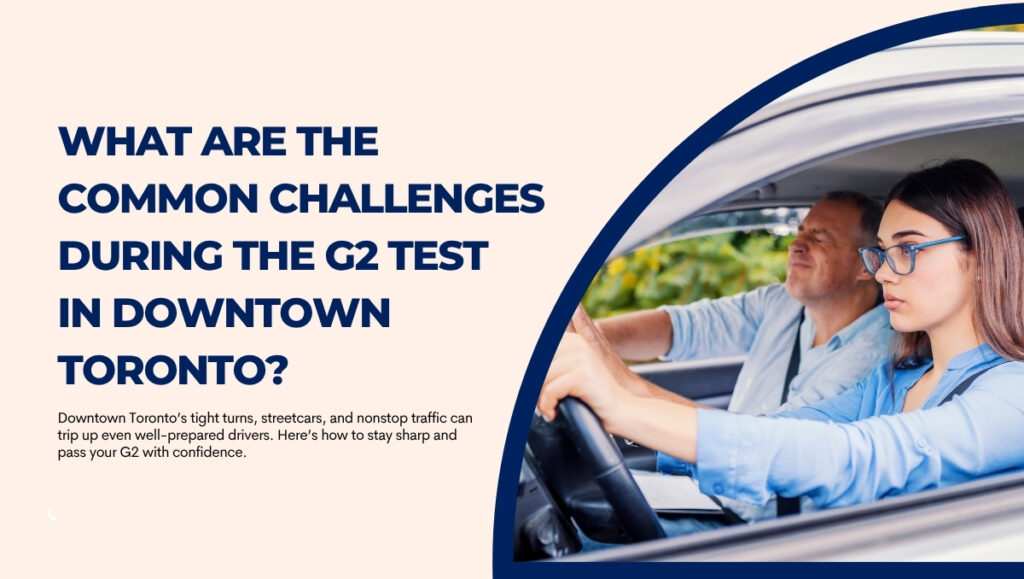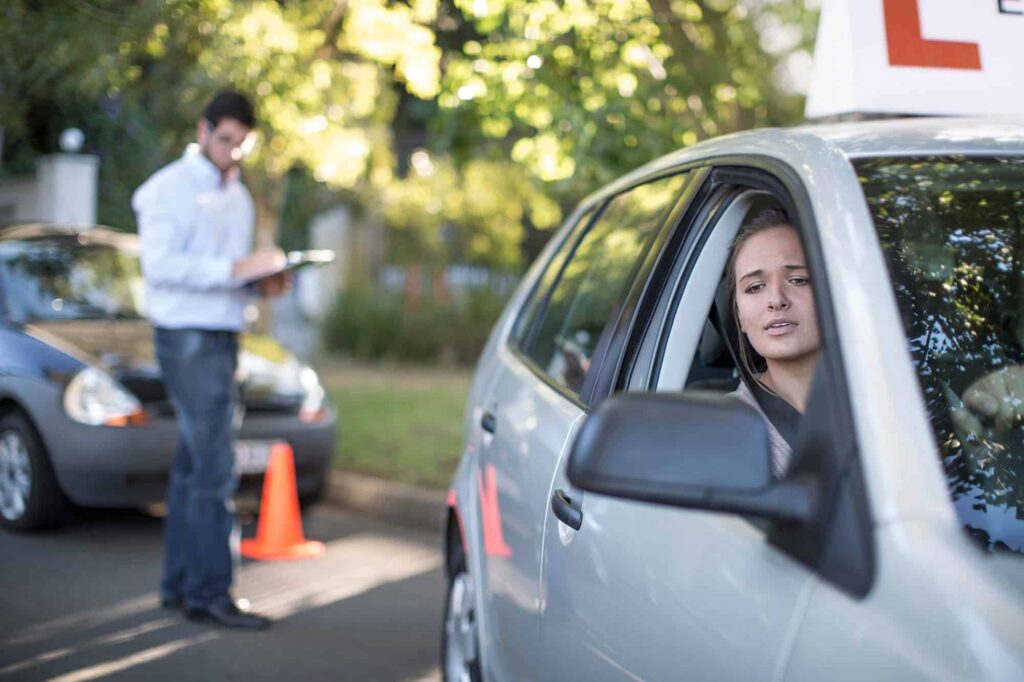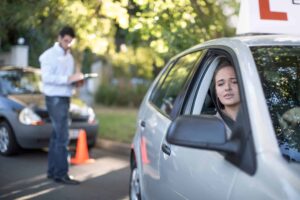The transition from G1 to G2 in Ontario’s graduated licensing system marks a pivotal milestone for learner drivers. With a G2 licence, you gain the freedom to drive unaccompanied, open up new job and social opportunities, and begin the countdown toward a full G licence.
Yet the G2 test is more than a symbolic rite of passage; it evaluates your ability to handle real-world driving conditions safely and competently. Many learners ask, “What are the common challenges during the G2 test in downtown Toronto?”
The answer lies in the city’s busy streets, where the urban grid teems with cars, streetcars, cyclists, delivery vans, and throngs of pedestrians.
In this high-pressure environment, the stakes are even higher. One misjudgment at a busy intersection like Queen and Bay can easily tip the balance from success to failure.
In this deep-dive guide, we’ll dissect every facet of the downtown G2 test experience: from the anatomy of the test itself to the eight most common challenges you’ll face, and finally, the proven strategies and tools you can deploy to conquer them.
By the end, you’ll have a systematic, research-backed preparation plan tailor-made for downtown Toronto’s unique driving landscape.
Why Downtown Toronto Poses Unique Hurdles?
Downtown Toronto’s core is a compressed patchwork of narrow lanes, one-way streets, constant transit movements, and unpredictable pedestrian traffic.
Peak-hour traffic volumes on arterials such as Bay Street routinely exceed 1,500 vehicles per hour in each direction, and downtown’s pedestrian density can top 3,000 people crossing major intersections every hour.
Add the complexity of streetcar tracks running down centre lanes, diagonal crosswalks at key junctions, and construction detours that pop up with little warning, and you have a high-pressure testing environment unlike any other part of the GTA.
Anatomy of the G2 Test in Downtown Toronto
Downtown Toronto isn’t an easy place to take your G2 test. With busy streets, streetcars, and constant traffic, it can be tough for new drivers. Here’s a clear look at what to expect and how to get ready.
Typical Test Route Length and Time Window
A standard G2 test in Toronto runs approximately 20 to 30 minutes and spans 8 to 12 kilometres, depending on traffic conditions and route variations. Examiners aim to steer candidates through a representative sample of downtown scenarios, including quiet residential streets, mixed-traffic arterials, and a handful of complex intersections within a two-kilometre radius of the test centre.
Core Competencies Assessed
- Vehicle Control: Smooth acceleration and braking, precise steering input, and steady speed maintenance.
- Observation: Effective use of mirrors, blind–spot checks, and scanning at least 10–15 metres ahead to anticipate hazards.
- Decision-Making: Judicious gap selection for lane changes, safe negotiation of uncontrolled intersections, and courteous interactions with other road users.
Common Scoring Criteria and Automatic Failures
Examiners deduct points for minor errors such as improper mirror usage, delayed signaling, or incomplete stops.
However, certain infractions lead to automatic failure: stalling the vehicle in an intersection, running a red or stop signal, disobeying an examiner’s direction, or any dangerous action that forces another road user to alter course.
The Downtown Driving Environment
Driving downtown isn’t like driving anywhere else. Tight lanes, constant traffic, and endless distractions make it a real test of skill and focus.
High Traffic Volumes and Peak-Hour Surges
Between 7:30–9:30 AM and 4:30–6:30 PM, downtown core corridors can swell to nearly double their off-peak volumes. Gridlock at Yonge & Dundas can delay progress by up to three signal cycles, testing both patience and clutch control.
Prevalence of One-Way Streets and Narrow Lanes
Approximately 20% of downtown streets operate one-way to manage flow, and lanes can be as narrow as 2.7 metres, which is barely more than a mid-size sedan’s width. This demands precise lane positioning and heightened spatial awareness.
Frequent Interactions with Streetcars and Buses
Toronto’s streetcars share curb lanes downtown, stopping frequently to pick up and drop off passengers. Drivers must know to stop at least one metre behind a stopped streetcar and re-enter traffic safely after it pulls away. Similarly, transit buses frequently weave in and out of traffic to reach stops.
Density of Pedestrians and Cyclists
At major junctions like King & Bay or Queen & Spadina, foot traffic can exceed 2,500 crossings per hour on weekends. Bike lanes along Richmond, Adelaide, and University Avenue create constant lateral movement that demands vigilant mirror and shoulder checks.
Abundance of Signalized and Unsignalized Intersections
Within a four-kilometre stretch of the downtown core, drivers encounter over 200 signalized intersections and dozens more four-way stops or yield-controlled junctions. Recognizing the correct right-of-way rules under pressure is critical.
What are the Common Challenges During the G2 Test in Downtown Toronto?
Thinking about your G2 test downtown? Expect tight lanes, tricky streetcars, and nonstop distractions to challenge your skills.
Common Challenge #1: Navigating Traffic Congestion
Downtown traffic is constant and unpredictable. Learning to stay calm and make smart decisions in heavy congestion is one of the biggest hurdles for G2 drivers.
Morning vs. Evening Rush-Hour Patterns
Morning inbound commuters flood University and Bay Streets, while evening exodus shifts west along Queen’s Quay and Lakeshore Boulevard. Awareness of directional patterns helps you choose test slots with lighter traffic flow.
Gridlock Hotspots
Intersections such as Yonge & Dundas and King & Bay see an average of 60–70 vehicles backed up per cycle during peak times, making smooth progress difficult. These hotspots often appear on test routes.
Managing Stop-and-Go Flow Without Stalling
Repeated clutch-and-gas modulation in heavy traffic can induce stalls. Practise “creep control” by finding the friction point and lightly resting your foot on the accelerator to maintain a constant crawl.
Strategies: Scanning Far Ahead and Anticipating Brake Lights
Keep your gaze 15–20 metres ahead to spot brake lights early and avoid sudden stops. This technique reduces abrupt braking and demonstrates anticipation to your examiner.
Common Challenge #2: One-Way Streets and Lane Discipline
One-way streets can appear suddenly, and narrow lanes leave little room for error. Staying alert and in the correct lane is key to avoiding critical mistakes.
Identifying and Interpreting One-Way Signage Quickly
Practice spotting one-way signs within your first two seconds of entering any downtown block. They’re often mounted on pole tops or painted on the curb.
Proper Lane Selection Before Intersections
Downtown multi-lane streets can split into dedicated left, through, and right lanes with yellow road markings just metres before intersections. Missing the cue leads to last-minute lane changes, which is a critical error.
Avoiding Illegal Turns and Wrong-Way Entries
Wrong-way infractions can occur when you fail to notice “Do Not Enter” markings. Regularly practice rides in one-way grids at off-peak times to build familiarity with typical downtown patterns (e.g., alternating one-way diagonals near Bay & Bloor).
Practice Drills: Route-Mapping and In-Car Cue Reminders
Before each session, map a 10–15 minute circuit through one-way zones in Google Street View. Use small sticky notes on your dashboard as reminders of typical entrance and exit points.
Common Challenge #3: Streetcar Interactions
Streetcars share the road in downtown Toronto, and knowing when to stop, wait, or pass is crucial. One wrong move can lead to an automatic fail.
Recognizing Streetcar Stops and Curb-Lane Sharing
Downtown streetcars run every 3–5 minutes on major arteries. Learn to spot the yellow platform edges and TTC symbols that signal upcoming stops.
Safe Passing Distances and Yielding Rules
Ontario law requires at least a one-metre buffer when passing a stopped streetcar. Use this rule to guide your lateral positioning.
Merging Back into Traffic After Passing Stopped Streetcars
After passing, yield to oncoming traffic and only merge when there’s a safe gap. Practise judgment by timing merge points on quiet streetcar routes like Spadina.
Simulation Exercises and Mirror-Scan Routines
Use dashcam footage or TTC live-stream feeds to simulate passing procedures. Develop a habit of checking mirrors and blind spots in a set sequence: left mirror → right mirror → over-the-shoulder.
Common Challenge #4: Complex Intersections & Turning Movements
Busy downtown intersections often involve multiple lanes, signals, and turning rules. Missing a cue or hesitating can lead to critical errors.
Multi-Lane Left Turns (e.g., Queen & Bay)
Left-turn lanes often split into two exit paths: one leading to off-ramps or service roads. Memorize signage and lane paint well in advance.
“Mixing” Intersections with Diagonal Crosswalks (e.g., Yonge & Bloor)
These “scramble” crosswalks let pedestrians cross diagonally and require drivers to understand when pedestrian-only phases occur.
Handling Unprotected Turns Against Oncoming Traffic
Unprotected left turns at intersections without dedicated signals (for example, some side-street turn bays around King & Jarvis) demand honed gap judgment.
Visualization Exercises and Decision-Point Marking
Walk through each intersection on foot or via Google Street View, marking safe “cut lines” where you’d complete turns. Practice these mental rehearsals before in-car sessions.
Common Challenge #5: Parallel Parking and Curb-Side Stops
Tight spaces, parked cars, and busy streets make parallel parking downtown especially tricky. Precision and control matter more than ever in these maneuvers.
Metered Parking Zones with Signage Restrictions
Downtown meters often have complex time restrictions. Knowing how to interpret pay-and-display rules while executing the maneuver adds cognitive load.
Tight Spacing Between Vehicles on Major Streets
Gaps of only 1.2–1.5 metres between cars require razor-sharp accuracy. Learning to use curb shadows and side-mirror alignment markers is vital.
Precision in Steering and Depth Perception
Build muscle memory by practicing in empty commercial lots with cones spaced at graduation intervals.
Practice in Off-Peak Commercial Lots and Quiet Side Streets
Seek large retail lots after hours or low-traffic side streets (such as Mercer Street near the Entertainment District) for low-stakes practice.
Common Challenge #6: Observing Pedestrians and Cyclists
Downtown streets are full of people and bikes. Missing a pedestrian at a crosswalk or failing to yield to a cyclist can cost you the test.
High Foot-Traffic Corridors (e.g., Queen West, King West)
Foot traffic here can surge to 4,000 crossings per hour during weekend events. Adopt a “pedestrian-first” mindset, always prepared to yield.
Bike Lanes and Cyclist Priority Rules
Respect designated bike lanes, avoid encroaching on them, and remember that cyclists have priority when merging across lanes.
Eye-Contact and Clear Yielding Behavior
Making eye-contact with pedestrians at crosswalks demonstrates courtesy and compliance, which examiners note favorably.
Role-Play Scenarios and Dashcam Review
Have a friend walk through simulated crossings while you drive slowly. Record it on dashcam to review your head-check timing and stopping distance.
Common Challenge #7: Signaling, Scanning & Communication
Proper signaling, constant scanning, and clear communication keep you visible and predictable. Miss a signal or skip a mirror check, and you could lose crucial points.
Timely Use of Turn Signals in Dense Traffic
Signals should activate at least three seconds before a lane change or turn in stop-and-go conditions. This gives the following drivers adequate warning.
Blind-Spot Checks Amid Multiple Moving Elements
With buses, cars, and cyclists all present, a rapid left-mirror → over-the-shoulder → right-mirror sequence before every lateral movement is essential.
Communicating Intent with Other Road Users
Gentle hand waves to thank courteous drivers or a slight tap of your horn (only when permitted) can defuse tense situations.
Drill: “Signal-Scan-Execute” Checklist
Before each lane change: Signal → Scan mirrors/blind spots → Execute. Rehearse this three-step drill on long, straight stretches like Bay Street at off-peak times.
Common Challenge #8: Mental Load & Decision-Making Under Pressure
Downtown driving demands quick thinking and calm under pressure. With so much happening at once, staying focused and making smart decisions is one of the toughest parts of the G2 test.
Managing Anxiety When Stuck at Long Lights
Use breathing techniques such as inhaling for four counts and exhaling for six to calm nerves during prolonged red signals.
Quickly Adapting to Unexpected Closures or Detours
Construction re-routes can appear on short notice. Cultivate a mindset of “Plan B” by always noting at least one alternate street for your route.
Maintaining Composure After a Minor Mistake
If you inch too far into an intersection or miss a turn, don’t panic. Pull over safely later, reset mentally, and refocus on the next instruction. Examiners value composure as much as technical skill.
Mindfulness Techniques and Instructor-Led Mock Tests
Incorporate short mindfulness sessions before your drive. Combine this with at least two full-length mock tests under timed conditions to simulate real-test stress.
Overcoming the Challenges: Preparation Strategies
Downtown driving isn’t easy, but the right preparation can make all the difference. With smart strategies and targeted practice, you can face the G2 test with confidence.
Route Familiarization Using Google Street View and Local Apps
Virtually “drive” your potential test routes ahead of time, noting one-way patterns, bus zones, and common streetcar stops.
Timing Practices for Different Times of Day
Schedule practice drives at 8 AM, noon, 5 PM, and late evening to experience the full spectrum of downtown traffic conditions.
Partnering with a Certified Instructor Familiar with Downtown Routes
Choose an instructor who regularly conducts G2 tests in downtown centres. Their insights into examiner expectations and route quirks can shave weeks off your prep time.
Structured Practice Plans Targeting Each Challenge
Design a six-week plan:
- Weeks 1–2: Traffic flow drills
- Weeks 3–4: Streetcar and lane-discipline exercises
- Weeks 5–6: Complex intersections and mock tests
Resources & Tools
From route maps to mock test videos, the right tools can speed up your learning and boost your confidence on test day.
Recommended Apps
- Toronto Traffic Cams: Live feeds of downtown intersections
- Driving Test Success: Customizable route simulators
- MyRoadMate Dashcam: Easy recording and clip extraction for self-review
Online Communities
- r/TorontoDriving subreddit: Peer tips, route discussions, and community support
Conclusion
Downtown Toronto’s G2 test demands mastery of traffic congestion management, one-way grids, streetcar sharing, complex intersections, precision parking, and constant vigilance for vulnerable road users. Each of these challenges is surmountable with targeted practice, mental preparation, and the right tools.
By following a structured six-week plan, logging your progress, and simulating real-test conditions, you replace anxiety with anticipation. Remember: consistency beats cramming.
Your unique insights, whether it’s a lesser-known quiet street for parallel parking or a streetcar strategy that saved your test, can help fellow GTA learners. Drop your tips below and join the community driving toward success!






